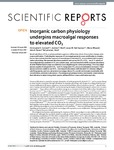Inorganic carbon physiology underpins macroalgal responses to elevated CO2
Date
2017-04-18Author
Subject
Metadata
Show full item recordAbstract
<jats:title>Abstract</jats:title><jats:p>Beneficial effects of CO<jats:sub>2</jats:sub> on photosynthetic organisms will be a key driver of ecosystem change under ocean acidification. Predicting the responses of macroalgal species to ocean acidification is complex, but we demonstrate that the response of assemblages to elevated CO<jats:sub>2</jats:sub> are correlated with inorganic carbon physiology. We assessed abundance patterns and a proxy for CO<jats:sub>2</jats:sub>:HCO<jats:sub>3</jats:sub><jats:sup>−</jats:sup> use (δ<jats:sup>13</jats:sup>C values) of macroalgae along a gradient of CO<jats:sub>2</jats:sub> at a volcanic seep, and examined how shifts in species abundance at other Mediterranean seeps are related to macroalgal inorganic carbon physiology. Five macroalgal species capable of using both HCO<jats:sub>3</jats:sub><jats:sup>−</jats:sup> and CO<jats:sub>2</jats:sub> had greater CO<jats:sub>2</jats:sub> use as concentrations increased. These species (and one unable to use HCO<jats:sub>3</jats:sub><jats:sup>−</jats:sup>) increased in abundance with elevated CO<jats:sub>2</jats:sub> whereas obligate calcifying species, and non-calcareous macroalgae whose CO<jats:sub>2</jats:sub> use did not increase consistently with concentration, declined in abundance. Physiological groupings provide a mechanistic understanding that will aid us in determining which species will benefit from ocean acidification and why.</jats:p>
Collections
Publisher
Place of Publication
Journal
Volume
Issue
Pagination
Number
Recommended, similar items
The following license files are associated with this item:


